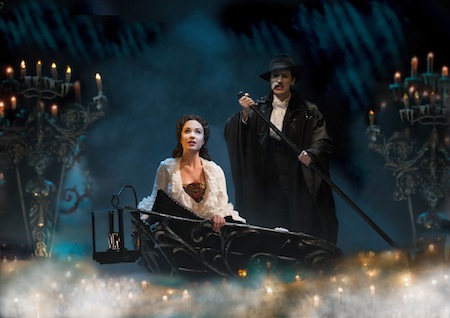"Phantom of the Opera" Showcases Rich Parisian History
Phantom of the Opera
Majestic Theater
247 W. 44th Street
New York, N.Y.

The Phantom of the Opera, the longest-running play in American history, celebrates its 25th anniversary in New York Saturday night. There will once again be “oohs” and “aahs” when the huge chandelier falls on stage, scary moments when the Phantom threatens people and, start to finish, some of the most luscious music ever written for the stage.
Theatergoers will see the enchanting musical, as good as ever after all these years, and shudder as the ogrish Phantom takes the beautiful actress Christine across the foreboding lake beneath the Paris Opera House to his lair. They will revel in French history, with all of its odd turns, that set the stage for the 1911 novel Le Fantome de L’Opera, by Gaston Leroux, and the hit 1925 silent movie version of it, starring the hideously made up Lon Chaney. While it was Andrew Lloyd Webber’s wonderful music, and the character of the Phantom, that made the musical so successful, it was the history that always gave it strength, whether in 1925 movie theaters or in the 148 cities in 28 countries where the musical has been staged.
The story of the Paris Opera House, and its unusual underground lake, started in violence. There was an assassination attempt on Emperor Napoleon III (Louis-Napoleon) in 1858. He and his entourage arrived at the front of a theater in Paris and were bombed. The three explosions killed eight people and wounded 142. Napoleon was not hurt. The rattled emperor then demanded that a large theater be built in Paris with a side entrance so that he and other dignitaries could get out of their carriage and make a quick entrance into the building through a side door for their protection. Hence, several years later, in the 1860s, the Paris Opera House, designed by Charles Garnier with a side entrance, opened.
The gorgeous building, that seats 2,000, has seventeen stories, seven underground, and, at the bottom, the fabled lake from The Phantom of the Opera story. The lake was created when workers accidentally broke open an underground pipe. Surrounding the lake, and taking up several more lower level floors, are dozens of halls full of costume shops and props.
You learn a lot of history watching the show, produced by Cameron Mackintosh. The story (book is by Webber and Richard Stilgoe and lyrics by Charles Hart) is set around 1900 with everyone in period costumes. The opera house in the story is a recreation of the Paris Opera House in that period. There is even a man who comes out to light the footlights in the front of the stage. People travel in carriages. The large staircase of a typical 1900-era mansion is recreated at the start of act two.
It takes a calculator to run up the numbers of Phantom. More than 130 million people have seen it worldwide. Grosses are $5.6 billion, or twice that of the film Avatar. There have been more than 65,000 performances in 13 languages and a movie. The album has sold 40 million copies, the bestselling theater album ever. There are currently six productions worldwide and another U.S. national tour is planned.
I saw the musical, directed by Hal Prince, again last week, 25 years after I saw it the first time. It is even more powerful now. Phantom is the classic story of beauty and the beast, the handsome, loving rescuer and tragedy in the end, a tale that always succeeds.
The show’s special effects have always won it praise, but it is the actors who carry it. I caught Jeremy Stolle as the Phantom and Marni Raab as Christine. Kyle Barisich was Christine’s lover, Raoul. They were wonderful. The hit songs of the musical, such as Think of Me, Phantom of the Opera, Angel of Music and Music of the Night, are as moving today as they were twenty-five years ago.
Phantom is still a winner and, with a little bit of luck, might run another twenty-five years.
My wife and I took a tour of the Paris Opera House ten years ago. The guide looked at us with a slight smile on her lips. “I am going to show you all of the Paris Opera House today,” she said. “We won’t be able to see the Phantom downstairs, though. He’s out on his lunch break.”
No. He’s actually on Broadway and, based on ticket sales, will be haunting the Majestic Theater for years to come, continuing to give audiences a grisly piece of old Paris in the heart of contemporary Manhattan.
PRODUCTION: Produced by Cameron Mackintosh and the Really Useful Theater Company. Sets: Maria Bjornson; Lighting: Andrew Bridge; Sound: Mick Potter and Martin Levan; Choreography: Gillian Lynne. The musical is directed by Harold Prince.
